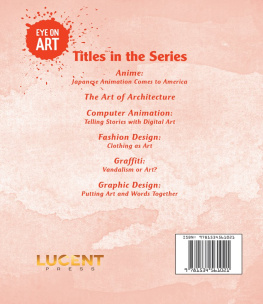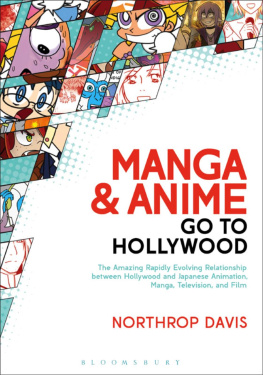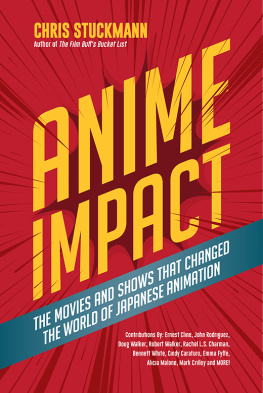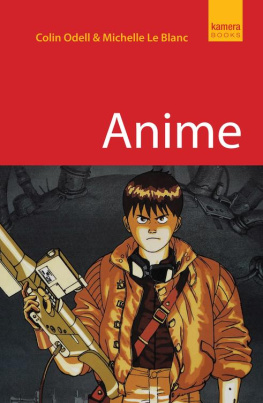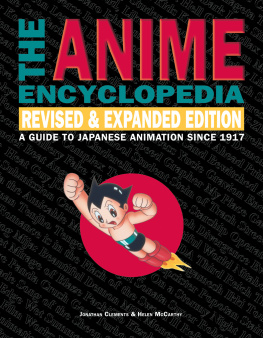Kenneth L. Bartolotta - Anime: Japanese Animation Comes to America
Here you can read online Kenneth L. Bartolotta - Anime: Japanese Animation Comes to America full text of the book (entire story) in english for free. Download pdf and epub, get meaning, cover and reviews about this ebook. year: 2018, publisher: Greenhaven Publishing LLC, genre: Art. Description of the work, (preface) as well as reviews are available. Best literature library LitArk.com created for fans of good reading and offers a wide selection of genres:
Romance novel
Science fiction
Adventure
Detective
Science
History
Home and family
Prose
Art
Politics
Computer
Non-fiction
Religion
Business
Children
Humor
Choose a favorite category and find really read worthwhile books. Enjoy immersion in the world of imagination, feel the emotions of the characters or learn something new for yourself, make an fascinating discovery.
- Book:Anime: Japanese Animation Comes to America
- Author:
- Publisher:Greenhaven Publishing LLC
- Genre:
- Year:2018
- Rating:3 / 5
- Favourites:Add to favourites
- Your mark:
- 60
- 1
- 2
- 3
- 4
- 5
Anime: Japanese Animation Comes to America: summary, description and annotation
We offer to read an annotation, description, summary or preface (depends on what the author of the book "Anime: Japanese Animation Comes to America" wrote himself). If you haven't found the necessary information about the book — write in the comments, we will try to find it.
Anime: Japanese Animation Comes to America — read online for free the complete book (whole text) full work
Below is the text of the book, divided by pages. System saving the place of the last page read, allows you to conveniently read the book "Anime: Japanese Animation Comes to America" online for free, without having to search again every time where you left off. Put a bookmark, and you can go to the page where you finished reading at any time.
Font size:
Interval:
Bookmark:

Published in 2018 by
Lucent Press, an Imprint of Greenhaven Publishing, LLC
353 3rd Avenue
Suite 255
New York, NY 10010
Copyright 2018 Greenhaven Press, a part of Gale, Cengage Learning
Gale and Greenhaven Press are registered trademarks used herein under license.
All new materials copyright 2018 Lucent Press, an Imprint of Greenhaven Publishing, LLC.
All rights reserved. No part of this book may be reproduced in any form without permission in writing from the publisher, except by a reviewer.
Designer: Seth Hughes
Editor: Jennifer Lombardo
Cataloging-in-Publication Data
Names: Bartolotta, Kenneth.
Title: Anime: Japanese animation comes to America / Kenneth Bartolotta.
Description: New York: Lucent Press, 2018. | Series: Eye on art | Includes index.
Identifiers: ISBN 9781534561021 (library bound) | ISBN 9781534561038 (ebook)
Subjects: LCSH: Animated films--Japan--Juvenile literature.
Classification: LCC NC1766.J3 M28 2018 | DDC 791.43340952--dc23
Printed in the United States of America
CPSIA compliance information: Batch #BS17KL: For further information contact Greenhaven Publishing LLC, New York, New York at 1-844-317-7404.
Please visit our website, www.greenhavenpublishing.com. For a free color catalog of all our high-quality books, call toll free 1-844-317-7404 or fax 1-844-317-7405.
Contents
Foreword
Introduction
Anime: A Global Phenomenon
Chapter One
Animes Origins
Chapter Two
Americanizing Anime
Chapter Three
Why Anime Stands Out
Chapter Four
Animes Strong Female Roles
Chapter Five
Animes Deeper Meaning
Chapter Six
A Blending of Cultures
Notes
For More Information
Index
Picture Credits
About the Author
Foreword
W hen many people think of art, the first things that come to mind may be paintings, drawings, sculptures, or even pictures created entirely with a computer. However, people have been applying artistic elements to almost every aspect of life for thousands of years. Human beings love beautiful things, and they seek beauty in unlikely places. Buildings, clothes, furniture, and many other things we use every day can all have an artistic aspect to them.
Attempts to define art have frequently fallen short. Merriam-Webster defines art as something that is created with imagination and skill and that is beautiful or that expresses important ideas or feelings. However, almost no one refers to the dictionary definition when attempting to decide whether or not something can be considered art. They rely on their intuition, which leaves much room for debate between competing opinions. What one person views as beautiful, another may see as ugly. An idea that an artist feels it is important to express may hit home with some people and be dismissed by others. Some people believe that art should always be beautiful, while others feel that art should be unsettling enough to pull people out of their comfort zone. With all of these contradictory views, it is no wonder that the question of what is art is so often disputed.
This series aims to introduce readers to some of the more unconventional and controversial art forms, such as anime, fashion design, and graffiti. Debate on these topics has often been heated, with some people firmly declaring that they are art and others declaring just as firmly that they are not. Each book in the series discusses the history of a particular art form, the ways it is created, and the reasons why it is considered artistic. Learning more about these topics helps young adults recognize the art that is all around them as well as form their own opinions about this complex subject.
Quotes by experts in various art fields enhance the engaging text. All quotes are cited so readers can trace them back to their original source, giving them a starting point for further research. A list of recommended books and websites also allows young adults to delve deeper into related subjects. Full-color photographs give vivid examples of the artistic works being described in the books so readers can visualize the terms they are learning.
Through this series, young adults gain a better understanding of a variety of popular art forms. They also develop a deeper appreciation for the artistry that is inherent in the things they see and use every day.
INTRODUCTION
Anime: A Global Phenomenon
T he world of anime has become a global phenomenon. Its reach extends well beyond the country of Japan from which it originated. Anime (pronounced AA-nuh-may) is Japanese animation which has found vast audiences in America as well as other countries across the globe. In the United States, anime refers only to Japanese animation, but in Japan, the word refers to all styles of animation, including Western animation. For the purposes of this book, the term anime will refer to Japanese animation only. In Japan, anime earns more than $5 billion per year. From broadcast and cable TV to movie theaters and home viewing, anime is enjoyed in all sorts of viewing formats. In addition to viewing anime, fans may also find the same stories and more in print as manga (pronounced MON-gah).
Anime is an art form that represents a number of distinct styles. Though most widely known for its iconic large eyes and vibrant colors, character design and proportions vary based on the artists particular style. Themes likewise range from tragedy to comedy; happy endings are never guaranteed.

Doraemon, one of the most ubiquitous manga and anime characters in Japan, is written and illustrated by Fujiko F. Fujio, the pen name of artists Hiroshi Fujimoto and Motoo Abiko. Originally published in 1969, Doraemon is a household name for children and adults alike.
The World of Anime
Anime has been produced in Japan for nearly a century, and mangas origins go back even further; many people believe the first manga were created in the 12th and 13th centuries, although the word manga was not used until 1798. Manga is the genre of graphic novels and comic books that sometimes, but not always, tell the same stories on the printed page that anime tells on the screen. Early anime was often based on characters and stories that initially appeared in manga. Even today, much of anime is adapted from manga, just as many American films are adapted from comic books, novels and similar sources.
The anime that most Americans see in theaters or on TV is a fraction of what is produced in Japan. Most of the anime available in America features adventure or science fiction stories, but in Japan, anime is used by filmmakers and TV show directors to tell a variety of stories, including romances, mysteries, historical dramas, sports dramas, slapstick comedies, and fairy tales. Writer Shinobu Price said, The only thing that really classifies anime as, well, anime is the fact that it is made in Japan by Japanese artists within a Japanese context. Stylistic experimentation with the medium is expectedrewarded if its good The creative realm of anime is vast, the possibilities endless.
In America, anime was regarded for years as an art form appreciated mostly by teenagersalthough there are exceptions, such as the Pokmon video games, films, and TV shows that appeal to young children. This may be because in Western culture, comics and cartoons have historically been considered to be for children and young adults. However, over the years, American adults began realizing that the stories told in anime and manga were deep and complex, and many came to appreciate the art form. This has long been the case in Japan; there, audiences range from very young children to adults.
Font size:
Interval:
Bookmark:
Similar books «Anime: Japanese Animation Comes to America»
Look at similar books to Anime: Japanese Animation Comes to America. We have selected literature similar in name and meaning in the hope of providing readers with more options to find new, interesting, not yet read works.
Discussion, reviews of the book Anime: Japanese Animation Comes to America and just readers' own opinions. Leave your comments, write what you think about the work, its meaning or the main characters. Specify what exactly you liked and what you didn't like, and why you think so.

